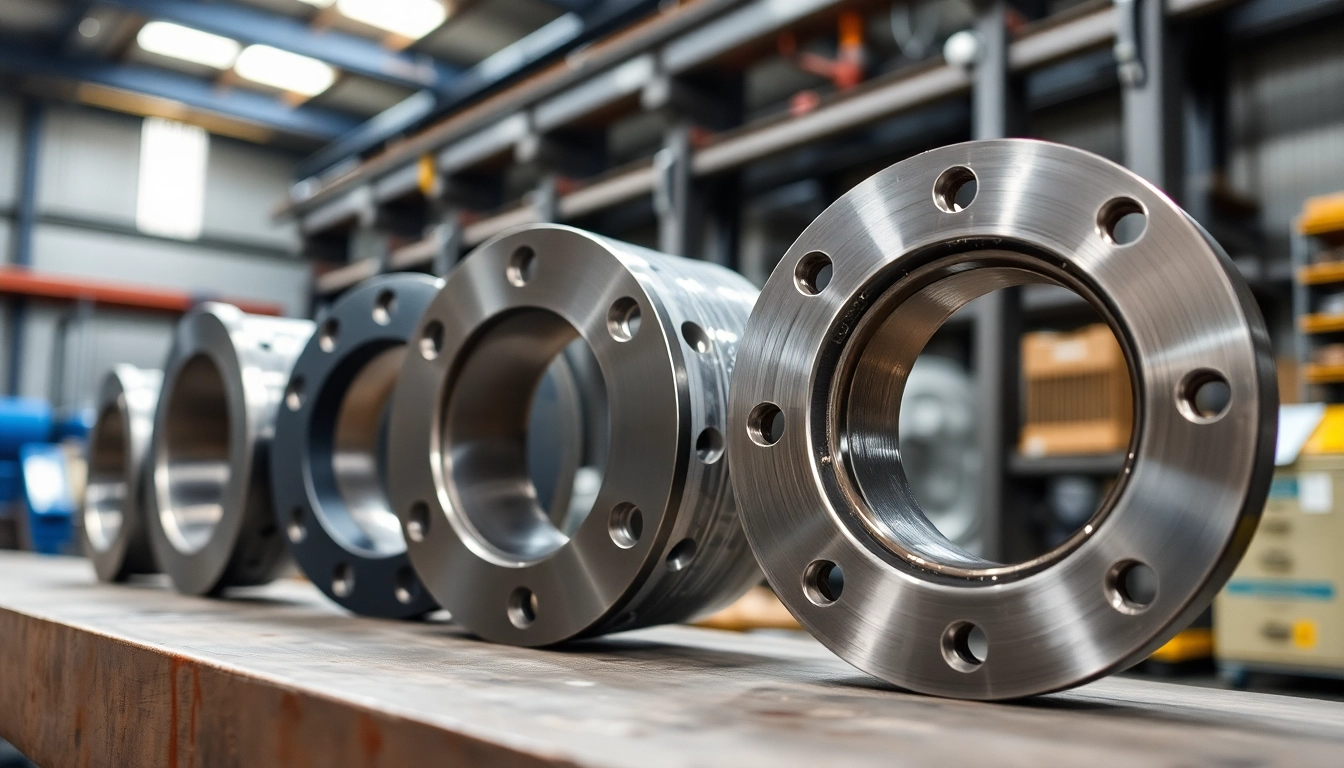1. Introduction to Flange Dimensions
Flanges are crucial components in various industrial applications, forming the backbone of piping systems and ensuring effective fluid transmission. Understanding the flange dimensions is vital for engineers and manufacturers alike, as they play a significant role in system integrity and performance. This guide provides a thorough exploration of flange dimensions, their importance, and the various factors that contribute to their proper selection and usage.
1.1 What Are Flanges?
Flanges are flat pieces of metal designed to connect pipes, valves, pumps, and other equipment in a piping system. They serve as a means for joining two sections of piping tightly and securely. They are typically welded or bolted together and are made from various materials, including stainless steel, carbon steel, and plastic. Flanges come in various shapes and sizes, contributing to their adaptability in different industrial environments.
1.2 Importance of Accurate Flange Dimensions
Accurate flange dimensions are paramount in ensuring that components fit together seamlessly, enabling a leak-proof and pressure-holding connection. Misaligned or improperly dimensioned flanges can lead to serious operational issues, including leaks, that can compromise safety and efficiency. Furthermore, in high-pressure or temperature applications, the stakes are even higher—with appropriate dimensions directly influencing the strength and durability of connections.
1.3 Overview of Different Flange Types
Flanges come in various types, each tailored for specific applications. The most common flange types include:
- Slip-On Flanges: Designed to slip over the pipe, these flanges are easy to align and weld.
- Blind Flanges: Used to seal the end of a piping system, preventing flow when necessary.
- Weld Neck Flanges: Featuring a tapered neck, these flanges provide excellent structural integrity, particularly in high-pressure environments.
- Socket Weld Flanges: Common in small diameters, these flanges are suitable for elevated temperature applications.
- Threaded Flanges: These are ideal for situations where welding isn’t feasible, offering a secure connection through threaded joints.
2. Key Specifications of Flange Dimensions
2.1 Standard Flange Dimensions and Measurements
Flange dimensions are standardized by various organizations, including the American National Standards Institute (ANSI) and the American Society of Mechanical Engineers (ASME). These standards provide a reference for dimensions such as the flange’s diameter, thickness, bolt circle diameter, and hole size. Commonly used standards include:
- ANSI/ASME B16.5
- ANSI/ASME B16.47
- ANSI/ASME B16.36
- API 605
Each standard outlines specific dimensions for different flange types and sizes, ensuring compatibility within piping systems.
2.2 Common Flange Material Considerations
The choice of material significantly impacts flange dimensions, performance, and durability. Common materials include:
- Stainless Steel: Offers excellent corrosion resistance and strength, suitable for a variety of applications.
- Carbon Steel: Provides good strength at a lower cost, often used in water and oil pipelines.
- Ductile Iron: Known for its tensile strength and ductility, used in high-pressure applications.
- Plastic: Lightweight and resistant to corrosion, ideal for low-pressure applications.
Understanding the mechanical properties and limitations of each material is fundamentally important when selecting flanges for specific applications.
2.3 How to Read Flange Dimension Charts
Flange dimension charts are essential tools for engineers and manufacturers. These charts provide detailed specifications, including diameters, thicknesses, and pressure ratings. Familiarizing oneself with how to interpret these charts is crucial:
- Locate the Flange Type: Identify the specific flange type you’re working with.
- Match the Size: Find the corresponding size based on the inner diameter (ID) or outer diameter (OD).
- Review Pressure Rating: Understand the class rating of the flange to determine its suitability for the intended application.
- Check Dimensions: Pay attention to specific dimensions that might affect installation, such as the bolt hole size and number.
3. Selecting the Right Flange Dimensions
3.1 Factors Influencing Flange Selection
Selecting the correct flange dimensions involves numerous considerations, including:
- Application Requirements: Consider the operational environment, temperature, and pressure.
- Fluid Type: The corrosiveness and characteristics of the fluid can dictate the choice of material and dimensions.
- Installation Space: Ensure that selected dimensions fit the available space within the piping layout.
Each of these factors plays a significant role in ensuring the reliability and safety of the piping system.
3.2 Matching Flange Dimensions to Pipe Systems
Flange dimensions must correspond closely to the pipe system for effective performance. This involves:
- Size Compatibility: Ensure that the flange dimensions match the pipe’s outer diameter.
- Pressure Ratings: Verify that both the flange and pipe can withstand the operational pressures.
- Connection Types: Match the flange type to the type of connection needed (welded, threaded, etc.).
Proper matching of dimensions and types minimizes the risk of leaks and operational failures.
3.3 Custom Flange Dimension Solutions
In some scenarios, standard flange dimensions may not meet specific project requirements. Custom flange solutions can be developed by:
- Consulting with Manufacturers: Experienced manufacturers can provide tailored options to meet unique specifications.
- Utilizing Advanced Design Software: CAD tools can help in designing flanges that fit unique operational parameters.
- Prototype Testing: Before implementing, creating prototypes allows for testing and adjustment.
4. Common Challenges with Flange Dimensions
4.1 Misalignment Issues in Flange Installation
Misalignment during installation can result in significant operational issues, including the risk of leaks. Common causes of misalignment include:
- Inappropriate flange dimensions
- Improper bolting techniques
- Installation in a constrained space
To overcome these issues, ensure careful alignment before fastening, and adhere strictly to installation guidelines.
4.2 Flange Dimension Tolerances and Their Impact
Tolerances refer to the permissible limits of variation in flange dimensions. Poor tolerance can lead to:
- Increased risk of leaks
- Difficulty in installation
- Increased wear and tear on components
Always consult tolerance specifications to select flanges that fit within approved limits, thus ensuring long-term reliability.
4.3 Troubleshooting Flange Dimension Problems
Identifying and correcting flange dimension issues is crucial for operational integrity. Some troubleshooting strategies include:
- Regular inspection of flanges for wear and alignment
- Utilizing dimensioning tools and gauges for accuracy
- Engaging in preventative maintenance practices to spot potential issues early
5. Best Practices for Flange Dimensions Management
5.1 Ensuring Consistency in Flange Dimensions
Consistency in flange dimensions is vital for system integrity. Best practices include:
- Standardizing dimensioning practices across projects
- Implementing quality control measures to ensure dimension accuracy
- Regular training for staff on flange specifications and installation
By establishing a consistent approach, organizations can enhance reliability and safety in designs.
5.2 Documenting Flange Dimensions for Projects
Thorough documentation is essential for clarity in project specifications. This involves:
- Creating detailed project documentation that outlines all necessary dimensions and standards.
- Maintaining records of the material selection and testing procedures.
- Utilizing digital platforms for easy retrieval and cross-referencing of dimension data.
Effective documentation practices streamline project management and facilitate troubleshooting down the line.
5.3 Future Trends in Flange Dimension Specifications
The industry is continually evolving, with trends indicating a shift towards:
- Advanced Materials: New materials with superior properties are emerging, potentially changing standard dimensions.
- Increased Standardization: As industries evolve, greater standardization in dimensions may arise to simplify design processes.
- Digital Transformation: Technology is leading the way in improving dimension measurement and modeling, enhancing precision.






